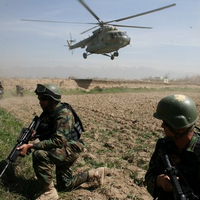BAGRAM, Afghanistan -- The two Russian-made helicopters swooped low over the village of Mahageer, pushing a stinging swirl of dust over the vineyards and pastures. The Mi-17 transports from the Afghan National Army Air Corps' Kabul Wing touched down in close formation, their rotors just yards apart. Squads of Afghan National Army commandos leaped from the choppers and fanned out, aiming their M-16 rifles. With the perimeter secure, the commandos pulled cardboard boxes from the helicopters. When their holds were empty, the Mi-17s lifted off, blasting the fields with a fresh wave of grit.
Last week's Afghan air assault had every appearance of a high-intensity combat operation, but it was actually a training event -- a sort of "final exam" for a team of Afghan troops attending a U.S. Army-led air assault school at Bagram Air Field, a major NATO facility outside Kabul. The air assault marked one of the first times that Afghan aviators had planned and executed a complex operation all on their own. The only NATO officers in attendance were instructors -- "graders," in essence -- on the ground, and one public affairs officer escorting a reporter on one of the helicopters.
"We've got to remember this is their war," Col. Don Galli, commander of the U.S. Army's 3rd Combat Aviation Brigade, told World Politics Review. Galli's troops run the Afghan air assault course, plus several other aviation-related courses. "We've got to have Afghan soldiers protecting the Afghan people."

